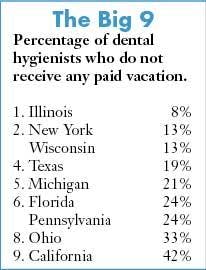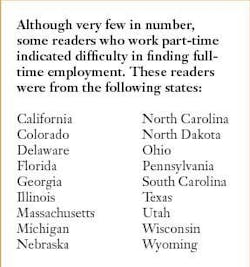RDH Salary & Benefits Survey
In the August 2004 issue, RDH published a two-page questionnaire. The questions focused on the income and other benefits earned by the magazine’s readers. The survey generated responses from 1,350 dental hygienists from all 50 states.1
The states with the largest number of responses were California (109), Michigan (84), Pennsylvania (74), Texas (74), Florida (63), Wisconsin (62), Illinois (54), New York (54), Ohio (52), Virginia (43), Colorado (41), New Jersey (41), Connecticut (35), North Carolina (35), and Georgia (31). The responses from the preceding 15 states represented 63 percent of the total.
With this article, there is no national perspective of salaries and benefits for the profession. Each state - with the exception of Alaska and Hawaii, as well as the District of Columbia - has some statistical information presented about it on subsequent pages. However, “rankings” about the “Big 9” (the nine states that provided 50 or more responses) are scattered throughout the state reports, indicating how these states compare in various categories.
RDH wishes to thank the readers who took the time to answer the questionnaire that was published last August.
Alabama14 respondents. Eight (57%) have practiced for 10 years or fewer. 12 (86%) work full time. Both part-time hygienists do so by choice. The average annual income in 2004 for full-time dental hygienists was $33,340. The average hourly rate is $22. Two (14%) reported at least part of income is based on commissions. Ten (71%) indicated they had received a raise within the last year; nine (64%) do not think they receive raises at fair intervals. Two (14%) do not receive paid vacation. In regard to health insurance, 43% are self-insured or rely on spouse’s plan; 36% are covered by employer’s plan; and 21% are uninsured. The average fee for #1110 procedure is $49.Arizonaº Urban: 11 respondents. Seven have practiced for 10 years or fewer. Ten work full time. The part-time hygienist reported that his or her work schedule was by choice. The average annual income in 2004 for full-time dental hygienists was $55,700. 91% reported earning an hourly rate; the average was $32 ($47 was the highest). 36% indicated they had received a raise within the last year; 36% do not think they receive raises at fair intervals. 9% do not receive paid vacation. In regard to health insurance, 73% are self-insured or rely on spouse’s plan; 18% are covered by employer’s plan; and 9% are uninsured. The average fee for #1110 procedure is $63.
º Suburban/rural: 30 respondents (23 indicated they practice in “suburban” settings). 21 (70%) have practiced for more than 11 years. 13 (43%) work full time. All of the part-time hygienists reported that their work schedule was by choice. The average annual income in 2004 for full-time dental hygienists was $59,120. 80% reported earning an hourly rate; the average was $33 ($43 was the highest). 7% reported at least part of income is based on commissions. 67% indicated they had received a raise within the last year; 23% do not think they receive raises at fair intervals. 13% do not receive paid vacation. In regard to health insurance, 57% are self-insured or rely on spouse’s plan; 30% are covered by employer’s plan; and 13% are uninsured. The average fee for #1110 procedure is $65.
VermontNine respondents. Eight have practiced for more than 11 years. Five work full time. The average annual income in 2004 for full-time dental hygienists was $44,200. The average hourly rate was $26. Six indicated they had received a raise within the last year; two do not think they receive raises at fair intervals. In regard to health insurance, seven are self-insured or rely on spouse’s plan; two are covered by employer’s plan. The average fee for #1110 procedure is $63.Washington23 respondents (18 indicated they practice in “urban” or “suburban” settings). 16 (70%) have practiced for more than 11 years. 14 (61%) work full time. All of the part-time hygienists reported that their work schedule was by choice. The average annual income in 2004 for full-time dental hygienists was $58,420. 87% reported earning an hourly rate; the average was $39 ($52 was the highest). 9% reported at least part of income is based on commissions. 52% indicated they had received a raise within the last year, and 48% do not think they receive raises at fair intervals. 13% do not receive paid vacation. In regard to health insurance, 48% are self-insured or rely on spouse’s plan; 48% are covered by employer’s plan; and 4% are uninsured. The average fee for #1110 procedure is $87.Wisconsinº Urban: 25 respondents. 13 (52%) have practiced for 10 years or fewer. 12 (48%) work full time. All of the part-time hygienists reported that their work schedule was by choice. The average annual income in 2004 for full-time dental hygienists was $47,880. 100% reported earning an hourly rate; the average was $26 ($29 was the highest). 4% reported at least part of income is based on commissions. 84% indicated they had received a raise within the last year; 28% do not think they receive raises at fair intervals. 12% do not receive paid vacation. In regard to health insurance, 79% are self-insured or rely on spouse’s plan; 17% are covered by employer’s plan; and 4% are uninsured. The average fee for #1110 procedure is $60.º Suburban: 18 respondents. 13 (72%) have practiced for more than 11 years. Seven (39%) work full time. One of the part-time hygienists reported being unable to find full-time employment. The average annual income in 2004 for full-time dental hygienists was $47,415. 100% reported earning an hourly rate; the average was $26 ($33 was the highest). 67% indicated they had received a raise within the last year; 39% do not think they receive raises at fair intervals. 22% do not receive paid vacation. In regard to health insurance, 50% are self-insured or rely on spouse’s plan; 33% are covered by employer’s plan; and 17% are uninsured. The average fee for #1110 procedure is $60.º Rural: 19 respondents. 13 (68%) have practiced for more than 11 years. 12 (63%) work full time. All of the part-time hygienists reported that their work schedule was by choice. The average annual income in 2004 for full-time dental hygienists was $45,235. The average hourly rate was $26 ($30 was the highest). 5% reported at least part of income is based on commissions. 79% indicated they had received a raise within the last year, and 26% do not think they receive raises at fair intervals. 5% do not receive paid vacation. In regard to health insurance, 74% are self-insured or rely on spouse’s plan; 16% are covered by employer’s plan; and 10% are uninsured. The average fee for #1110 procedure is $57.West VirginiaSeven respondents. Five have practiced for more than 11 years. Four work full time. The average annual income in 2004 for full-time dental hygienists was $34,500. The average hourly rate was $24. Two reported at least part of income is based on commissions. Four indicated they had received a raise within the last year; four do not think they receive raises at fair intervals. Three do not receive paid vacation. The average fee for #1110 procedure is $45.WyomingFive respondents. Four have practiced for more than 11 years. Two work full time. One of the part-time hygienists reported being unable to find full-time employment. The average hourly rate was $23. Four do not think they receive raises at fair intervals, and three do not receive paid vacation.The average fee for #1110 procedure is $59.1Readers from Alaska, District of Columbia and Hawaii contributed just two responses each, and an analysis of those six responses is not included. The state reports on subsequent pages often are based on whether a reader indicated an "urban," "suburban," or "rural" practice setting. In a few cases, the reader neglected to answer this specific question. If an analysis for a state contained a breakdown based on practice setting, these responses were discarded. If no breakdown based on practice setting was provided, these responses were included.








